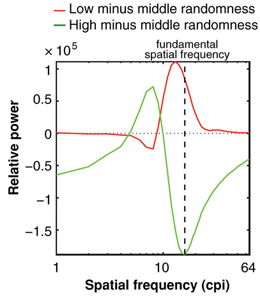パターンの乱雑さの残効
Pattern randomness aftereffect
2013年10月11日 Scientific Reports 3 : 2906 doi: 10.1038/srep02906

ヒトは、乱雑に配置された視覚的パターンと規則的な配置の視覚的パターンを容易に識別できる。今回我々は、ヒトの知覚システムが視覚的パターンの乱雑さに順応することを示す。観察者には、さまざまなレベルの物理的乱雑さを持つ2つの二次元ドットパターン(順応刺激)が画面の左右に5秒間提示された。その後、順応刺激と同じ位置に新たな2つのパターンがテスト刺激と比較刺激として提示され、どちらのパターンの乱雑さが高いかを判断してもらった。知覚された乱雑さは、高い物理的乱雑さに順応した後には低下し、低い物理的乱雑さに順応した後には上昇した(実験1)。22.5度回転させた順応刺激に対する順応では、乱雑さの残効が起こらなかった(実験2)。このことから、位置的変動がパターンの乱雑さの知覚に関与している可能性は低いと考えられる。さらに、残効は順応時とテスト時で刺激の輝度を反転させた場合でも生じ、コントラスト極性に対して選択性がない視覚処理が残効に関与していることを示唆する(実験3)。また、順応中に順応刺激の位置を一定の空間範囲内で500ミリ秒ごとにランダムに移動させても残効が観察されたことから、順応刺激が同じ網膜位置に提示されることは乱雑さの残効の原因ではないと考えられる(実験4)。最後に、テスト刺激の位置にのみ順応刺激を提示した場合であっても残効が生じることを確認した(実験5)。これらのデータは、方位入力に関するFRF(フィルター・整流・フィルター)処理を仮定したモデルと一致していた。従って我々は、方位の群化/分離に関わる神経的処理が、パターンの乱雑さの知覚の基盤になっていると考える。
山田 祐樹1*, 河邉 隆寛2 & 宮崎 真1
- 山口大学 時間学研究所
- NTTコミュニケーション 科学基礎研究所 人間情報研究部
* 現所属先:九州大学 基幹教育院

